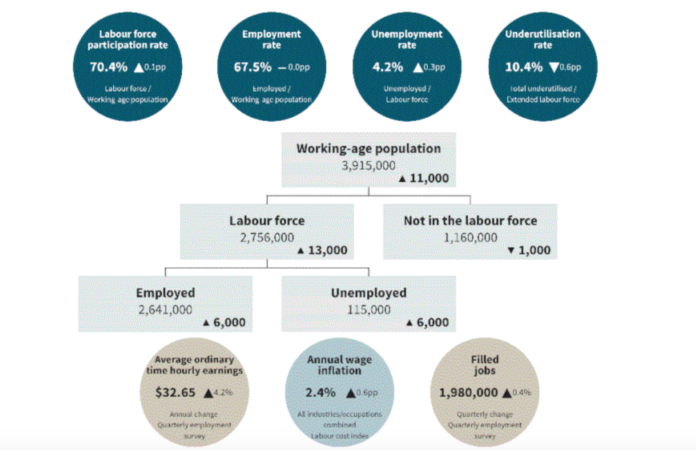The seasonally adjusted unemployment rate rose to 4.2 percent in the September 2019 quarter, up from 3.9 percent last quarter, Stats NZ said today.
The rise in the unemployment rate comes after a drop to an 11-year low in the June 2019 quarter, while the seasonally adjusted underutilisation rate fell to 10.4 percent.
This is the lowest underutilisation rate since the June 2008 quarter, when it was 9.9 percent.
“Labour market data is most useful when placed in the context of a time series,” prices senior manager Paul Pascoe said.
“While the unemployment rate has returned to the level seen in the March 2019 quarter, it has largely been tracking down since late 2012.”
“Despite the quarterly rise in unemployment, the underutilisation rate, which is a broader measure of spare capacity in the labour market, has fallen to the lowest level in over eleven years,” Mr Pascoe said.
“The fall in underutilisation this quarter was driven by a drop in the number of underemployed people, those who work part time but are looking to work more hours.”
Overall, the seasonally adjusted number of people who were underutilised fell by 18,000, to 295,000 in the September 2019 quarter. This is the first time since the March 2009 quarter that the number of underutilised people has been below 300,000.
The underutilisation rate for women fell to 12.6 percent, which is the lowest rate since the September 2008 quarter, when it was also 12.6 percent.
The underutilisation rate for men fell to 8.3 percent, which is the lowest rate since the December 2007 quarter, when it was 7.5 percent.
Underemployment a key driver in underutilisation fall
The decrease in underutilisation this quarter was driven by a fall in the number of underemployed people, down 15,000. Annually, there were 27,200 fewer (unadjusted) people underutilised. This change was split evenly between men and women, both decreasing by 13,600.
Underemployment summary – September 2019 quarter
The number of (unadjusted) people underemployed decreased by 15,100 over the year, driven by 11,900 fewer (unadjusted) underemployed women.
Of the total decrease in the number of underemployed people, 11,600 fewer were actively seeking more hours. This reflected 8,200 fewer underemployed women who were actively seeking more hours.
Annually, the median actual hours women worked in their main job increased from 32 to 35, while men remained at a median of 40 hours.
Of the total decrease in the number of underemployed people, 7,700 came from a decrease in underemployed 15–24-year-olds.
Employment rate steady
The seasonally adjusted employment rate remained steady at 67.5 percent in the September 2019 quarter. The employment rate for men also remained steady at 72.2 percent, while the employment rate for women dropped slightly to 62.9 percent, down from 63.0 percent last quarter.
Over the quarter, 6,000 more people were employed. The rise in the number of employed people was largely influenced by men (up 6,000), while the number of employed women also rose slightly (up 1,000). Annually, the number of employed people increased by 23,000. (Due to rounding, the seasonally adjusted breakdowns do not always add to the total change.)
Using unadjusted figures, over the year, the number of people in full-time employment increased by 51,800, which reflected 33,400 more women. The number of people in part-time employment (working fewer than thirty hours per week) decreased by 28,000 over the year, which reflected 21,900 fewer women.
“Over the year, there were more women working full time and fewer women working part time, as well as an increase in median hours worked by women,” Mr Pascoe said.
“Because an employee must be working part time to be considered underemployed, these changes may have contributed to decreases in underemployment.”
Wage rates grow over the year
The labour cost index (LCI) salary and wage rates (including overtime) increased 2.4 percent in the year to the September 2019 quarter.
Annually, public sector wage inflation was 3.0 percent, and private sector wage inflation was 2.3 percent.
Average ordinary time hourly earnings as measured in the quarterly employment survey (QES) increased by 4.2 percent annually, while both the public and private sectors increased by 3.9 percent annually.
See Pay settlements help push wage growth to a ten-year high for more information on wages in the September 2019 quarter.
Labour market summary – September 2019 quarter, seasonally adjusted
Data from September 2019 quarter’s household labour force survey (HLFS), quarterly employment survey (QES), and labour cost index (LCI), compared to the June 2019 quarter. HLFS results for the September 2019 quarter showed the labour force participation rate was 70.4%, up 0.1pp (percentage points). This rate is derived from labour force divided by working-age population. The employment rate was 67.5%, no change. This is derived from employed divided by working-age population. The unemployment rate was 4.2%, up 0.3pp. This is derived from unemployed divided by labour force. The underutilisation rate was 10.4%, down 0.6pp. This is derived from total underutilised divided by extended labour force. The working-age population was up 11,000 to 3,915,000. This is made up of the labour force, up 13,000 to 2,756,000, and people not in the labour force, down 1,000 to 1,160,000. The labour force is made up of employed people, up 6,000 to 2,641,000, and those unemployed, up 6,000 to 115,000. Average ordinary time hourly earnings from the QES were up 4.2% annually, to $32.65. Annual wage inflation from the LCI was up 0.6pp to 2.4%, for all industries and occupations combined. Filled jobs from the QES were up 0.4% for the quarter, to 1,980,000. Note: Household labour force survey data, unless otherwise stated. Data, including rates, is seasonally adjusted, excluding average ordinary time hourly earnings and annual wage inflation.
Text alternative for diagram, Underemployment summary – September 2019 quarter





